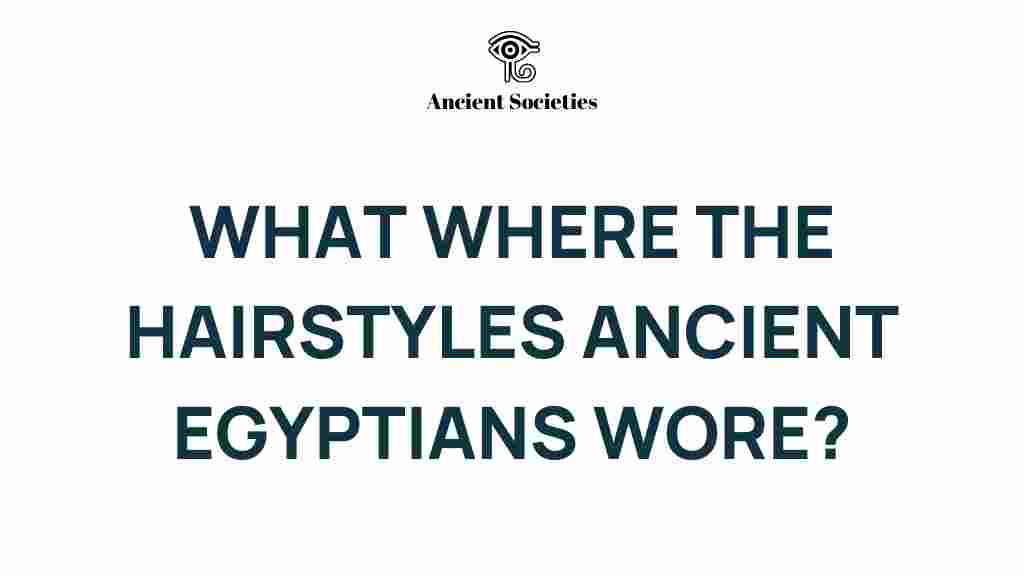Unveiling the Secrets of Ancient Egyptian Hairstyles
Throughout history, few cultures have captivated the imagination as much as Ancient Egypt. The rich tapestry of its culture, combined with its striking beauty and fashion, offers a glimpse into a world where hairstyles were not just a matter of aesthetics but also held deep significance. In this article, we will explore the fascinating world of ancient Egypt and its hairstyles, delving into their cultural importance, historical context, and the symbolism they carried in relation to social status.
The Historical Context of Ancient Egyptian Hairstyles
Hairstyles in ancient Egypt were more than just a fashion statement; they were a reflection of one’s identity, social status, and even religious beliefs. The ancient Egyptians placed great emphasis on appearance, and hair played a crucial role in their overall presentation. Throughout different periods, hairstyles evolved, influenced by changes in fashion, culture, and social dynamics.
- Old Kingdom (c. 2686 – 2181 BC): During this period, both men and women favored long hair, often adorned with braids and wigs.
- Middle Kingdom (c. 2055 – 1650 BC): A shift towards more elaborate hairstyles emerged, with the introduction of intricate wigs that became a status symbol.
- New Kingdom (c. 1550 – 1070 BC): This era saw the height of hairstyling sophistication, with elaborate headdresses and the use of gold and jewels.
Symbolism in Hairstyles
Understanding the symbolism behind ancient Egyptian hairstyles requires a closer look at their cultural practices. Hairstyles were often indicative of various aspects of life, such as:
- Social Status: Different hairstyles signified different social classes. Nobles and pharaohs wore more elaborate styles compared to commoners.
- Gender Roles: Men typically wore shorter hairstyles, while women’s hair was often longer and more ornate.
- Religious Significance: Certain hairstyles were reserved for priests and priestesses, reflecting their divine connection.
Step-by-Step Process of Ancient Egyptian Hairstyling
Creating an authentic ancient Egyptian hairstyle involves understanding the techniques and materials used by the Egyptians. Here’s a simple guide to recreate a basic ancient Egyptian hairstyle:
Materials Needed:
- Hair extensions or wigs
- Hair oils (such as castor or olive oil)
- Hair accessories (beads, gold threads)
- Combs and brushes
Steps to Create an Ancient Egyptian Hairstyle:
- Prepare the Hair: Start by washing and conditioning the hair. Apply hair oil to add shine and manageability.
- Section the Hair: Divide the hair into sections using a comb to make styling easier.
- Create Braids: Begin braiding sections of hair, as braids were a common feature in ancient Egyptian hairstyles.
- Add Extensions: If desired, add hair extensions to create length and volume. Secure them tightly.
- Decorate: Use beads, ribbons, and gold threads to adorn the hairstyle, reflecting the opulence of ancient Egyptian fashion.
- Final Touches: Ensure the hairstyle is secure and neat, ready to showcase your ancient Egyptian look.
Troubleshooting Tips
While recreating ancient Egyptian hairstyles can be a fun endeavor, challenges may arise. Here are some troubleshooting tips:
- Difficulty in Braiding: Practice makes perfect! Start with smaller sections of hair to gain confidence.
- Extensions Not Blending: Choose extensions that closely match your natural hair color for a seamless look.
- Hair Accessories Falling Off: Use hair ties or clips to secure accessories properly.
The Intersection of Archaeology and Ancient Egyptian Hairstyles
The study of ancient Egyptian hairstyles is deeply intertwined with archaeology. Excavations in tombs have uncovered various artifacts, including hairpieces, combs, and paintings depicting hairstyles. These findings provide invaluable insights into the grooming practices and aesthetic values of ancient Egyptians.
Archaeological evidence shows that wigs were highly regarded, often made from human hair or plant fibers. They were meticulously crafted and sometimes even enhanced with fragrances. The significance of wigs is further underscored by their presence in burial practices, where they were included in tombs as part of the afterlife journey.
Influence on Modern Beauty and Fashion
The fascination with ancient Egyptian culture continues to influence modern beauty and fashion. Contemporary hairstyles often draw inspiration from the intricate braids, curls, and accessories of ancient Egypt. Many beauty enthusiasts incorporate elements like:
- Gold hair accessories
- Intricate braiding techniques
- Wigs and hairpieces that mimic ancient styles
For those interested in learning more about the history of beauty and fashion in ancient cultures, you can explore the history of beauty practices.
Conclusion
In conclusion, the exploration of ancient Egyptian hairstyles reveals much about the culture, beauty ideals, and social structures of this fascinating civilization. Through the study of their hairstyles, we gain insights into the values and beliefs of the ancient Egyptians, as well as their remarkable artistry in personal grooming.
From the symbolism of hairstyles reflecting social status to the intricate techniques used in hairstyling, the legacy of ancient Egypt continues to inspire and inform modern beauty and fashion. Understanding these aspects not only enriches our appreciation of history but also allows us to celebrate the enduring influence of ancient cultures on contemporary practices.
For additional resources and a deeper dive into the world of ancient Egypt, visit this informative site.
This article is in the category Culture and created by AncientSocieties Team
